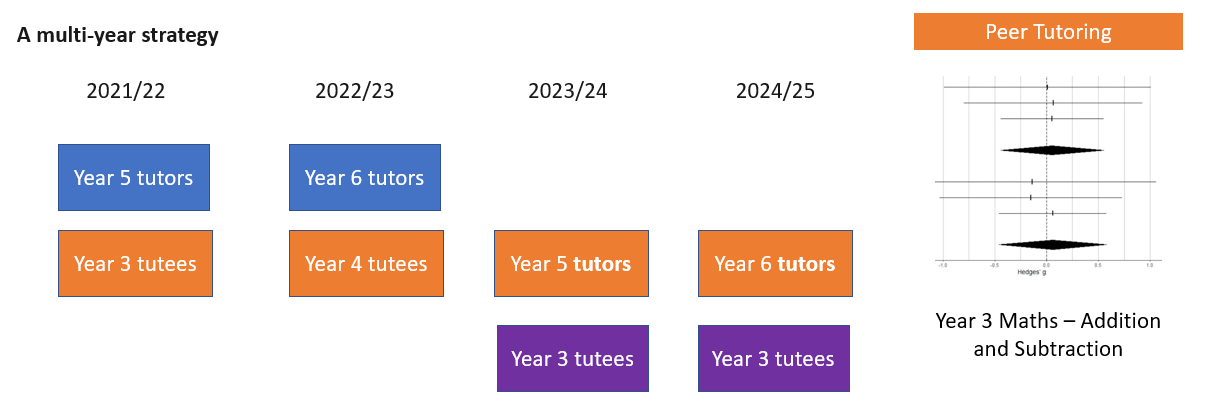The disruption to learning globally has been unprecedented due to the impact of COVID-19, with schools still encountering significant pressures even though many countries national restrictions have eased. In the UK, the National Foundation for Educational Research (NFER) has recently released a report into the impact of COVID on pupil attainment for primary pupils. The report shows negative impacts on reading progress was greatest among Key Stage 1 pupils, particularly those in Year 1. The study analysed trends across several Covid education impact papers and found that maths attainment was mostly affected among Key Stage 2 pupils. A concerning finding is that maths learning recovery in this age group was much slower that reading for Key Stage 2 (NFER, 2022).
As part of the government response, the creation of a National Tutoring Programme (NTP) to fund private tutors for disadvantaged learners is based on the evidence that one to one tuition has a positive impact on attainment, with approximately five additional months progress for learners. This high-cost intervention is a good bet for helping to close the attainment gaps for learners, but as a long-term solution this strategy does not build sustained capacity within the education system. Furthermore, the programme has encountered a number of challenges and has not been universally well received by schools. Now into its second year, the programme provides three routes to tutoring: tuition partners, academic mentors and school-led tutoring.
At present, if a school uses a tuition partner this is subsidised by 70% and the school contributes 30% of the cost of the intervention. Yet, in the next two academic years for 2022/23 and 2023/24, the subsidy reduces to 50% and then 25% of the cost (DFE, 2022). As schools are advised for by the DFE to use a 3-year strategy for their pupil premium reporting, it can be expected that this strategy will place further financial pressures on ever tightening school budgets. It can be expected that one to one tutoring from the National Tutoring Programme will gradually disappear from the pupil premium reporting as this subsidy reduces over the next two academic years.
A fundamental problem with the National Tutoring Programme approach, is the availability of highly qualified tutors. A report into the impact of private tuition by the Sutton Trust (2016) found that nearly half (43%) of state school-teachers have tutored outside of their main teaching role. Therefore, as teachers work during the hours when the NTP is delivered, we have a major capacity issue for high quality tutors when the system is scaled. Also, the challenges involved in delivering the tuition has been significant, which was to be expected in launching a major national intervention strategy when schools were facing the daily challenges COVID.
Yet, if we are
looking at evidence informed interventions, we have to look no further than a
few places on the Education Endowment Foundation (EEF) teaching and learning toolkit for an
alternative evidence-based solution. Peer tutoring is described as high impact for very low cost and based on
extensive evidence. The EEF show that:
- Effects are similar (5+ months) for both primary and secondary
age pupils.
- Impact is similar (5+ months) for both literacy and mathematics.
- Lower attaining pupils tend to benefit more (6+ months) than higher attaining
pupils.
- Impact on tutors is on
average slightly higher (6+ months), however the evidence is weaker due to
the limited number of robust studies. (EEF,2022)
Therefore, as a targeted intervention approach peer tutoring has the
potential to impact the attainment of both tutors and tutees. Yet, peer tutoring has not been adopted within
schools even in the early days of the Sutton Trust teaching and learning
toolkit. A survey by the Sutton Trust (2013) found 1 in 100 teachers using peer
tutoring schemes, even though the evidence showed this was a promising
approach.
In 2015, the EEF evaluated two large scale peer tutoring programmes, a
shared maths programme and an English secondary school paired reading
programme. The results showed no significant improvement in attainment for both
the programmes, which was surprising as the evidence base from numerous other
studies showed this is a promising approach. These results were surprising and
likely contributed to the lack of the schools adopting this type of
intervention. A recent rapid review at WhatWorked of three local authorities
(425 schools) found 80% of schools using research evidence to justify pupil
premium strategies but only 1% of schools planning to use peer tutoring in their
three-year strategy. An independent survey by Teacher Tapp (2020) of 6478 UK school
teachers found only 4% of primary and 12% of secondary were willing to consider
peer tutoring approaches if COVID restrictions permitted these.
The new EEF update for the teaching and learning toolkit includes the
two EEF large scale RCTs, and the overall evidence still shows that peer
tutoring has the potential as a high impact, low-cost intervention which is
based on extensive research evidence. So, can peer tutoring create a sustainable
intervention in schools to support COVID recovery?
At WhatWorked Education, we are supporting schools to test if peer tutoring can provide a targeted academic intervention in a multi-year approach to school pupil premium strategies. Initially working with primary schools, WhatWorked are supporting teachers with bespoke peer tutoring programmes for Key Stage 2 mathematics.
Teachers are provided with step-by-step support through the online programmes, providing the resources and allowing teachers the freedom to choose how they would like to evaluate the intervention in their school. The three-tiered approach uses either teacher observations (1 Star), a pre- and post-test single group design (2 Star) or a mini-randomised controlled trial (3 Star) whereby the WhatWorked team analyse the anonymised data for the teacher to provide an effect size of the impact. The use of the 3-star evaluations will allow the team at WhatWorked to build an evidence base using a cumulative meta-analysis approach, which is continuously updated as more schools complete the intervention.
The figure below demonstrates how the multi-year peer tutoring strategy in primary schools will work, with the initial Year 3 tutees switching roles in 2023 to become Year 5 tutors for a new cohort of Year 3 learners.
The benefits for adopting a peer tutoring approach are numerous, as the evidence demonstrates that students selected as tutors often gain as much as the tutee, particularly in cross-age peer tutoring with a two-year age gap. In addition, both tutors and tutees are developing key skills and building confidence in the subject.
Furthermore, the costs associated with peer tutoring a minimal compared to traditional one to one tutoring.
At WhatWorked, schools have the opportunity to test the concept for free for a KS2 Year 3 Addition and Subtraction pilot using Year 5 pupils from their own school to deliver the intervention. Then, a simple licence fee of £250 provides access to a further five Year 3 mathematics programmes and from September 2022, an additional six Year 4 peer tutoring programmes will be released. The licence includes support for the analysis of each intervention delivered, providing schools with robust evidence of the impact of the intervention to support their three-year pupil premium strategy.
The idea behind the National Tutoring Programme has good intentions, but as a sustainable and cost-effective solution for an in-school delivery programme I believe the way this is currently being implemented is fundamentally floored. Within the education system, we need to test if peer tutoring can be used as a long-term catch-up strategy as the research evidence shows this has the potential to make a positive impact on attainment.
Dr Wayne Harrison
Co-founder WhatWorked Education
References
DFE (2021) School-led tutoring guidance (NTP)
NFER (2022), The Impact of COVID-19 on pupil attainment: A summary of the research evidence.
Sutton Trust (2013)
Sutton Trust (2016) Shadow Schooling. Private tuition and social mobility in the UK. https://www.suttontrust.com/wp-content/uploads/2019/12/Shadow-Schooling-formatted-report_FINAL.pdf
Teacher Tapp (2020) NCFE commissioned research.



